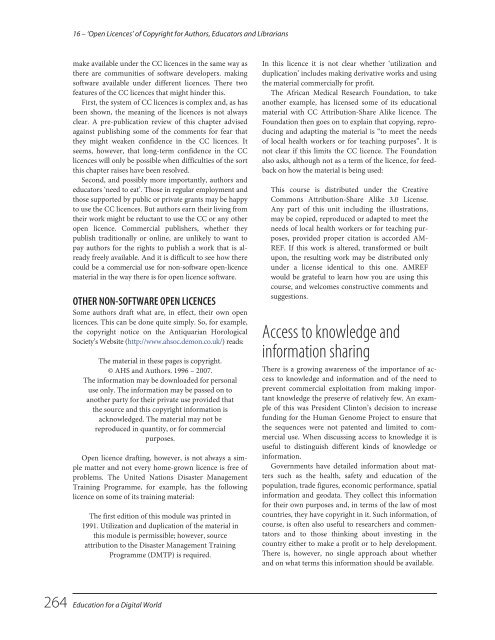Education for a Digital World Advice, Guidelines and Effective Practice from Around Globe, 2008a
Education for a Digital World Advice, Guidelines and Effective Practice from Around Globe, 2008a
Education for a Digital World Advice, Guidelines and Effective Practice from Around Globe, 2008a
You also want an ePaper? Increase the reach of your titles
YUMPU automatically turns print PDFs into web optimized ePapers that Google loves.
16 – ‘Open Licences’ of Copyright <strong>for</strong> Authors, Educators <strong>and</strong> Librarians<br />
make available under the CC licences in the same way as<br />
there are communities of software developers. making<br />
software available under different licences. There two<br />
features of the CC licences that might hinder this.<br />
First, the system of CC licences is complex <strong>and</strong>, as has<br />
been shown, the meaning of the licences is not always<br />
clear. A pre-publication review of this chapter advised<br />
against publishing some of the comments <strong>for</strong> fear that<br />
they might weaken confidence in the CC licences. It<br />
seems, however, that long-term confidence in the CC<br />
licences will only be possible when difficulties of the sort<br />
this chapter raises have been resolved.<br />
Second, <strong>and</strong> possibly more importantly, authors <strong>and</strong><br />
educators ‘need to eat’. Those in regular employment <strong>and</strong><br />
those supported by public or private grants may be happy<br />
to use the CC licences. But authors earn their living <strong>from</strong><br />
their work might be reluctant to use the CC or any other<br />
open licence. Commercial publishers, whether they<br />
publish traditionally or online, are unlikely to want to<br />
pay authors <strong>for</strong> the rights to publish a work that is already<br />
freely available. And it is difficult to see how there<br />
could be a commercial use <strong>for</strong> non-software open-licence<br />
material in the way there is <strong>for</strong> open licence software.<br />
OTHER NON-SOFTWARE OPEN LICENCES<br />
Some authors draft what are, in effect, their own open<br />
licences. This can be done quite simply. So, <strong>for</strong> example,<br />
the copyright notice on the Antiquarian Horological<br />
Society’s Website (http://www.ahsoc.demon.co.uk/) reads:<br />
The material in these pages is copyright.<br />
© AHS <strong>and</strong> Authors. 1996 – 2007.<br />
The in<strong>for</strong>mation may be downloaded <strong>for</strong> personal<br />
use only. The in<strong>for</strong>mation may be passed on to<br />
another party <strong>for</strong> their private use provided that<br />
the source <strong>and</strong> this copyright in<strong>for</strong>mation is<br />
acknowledged. The material may not be<br />
reproduced in quantity, or <strong>for</strong> commercial<br />
purposes.<br />
Open licence drafting, however, is not always a simple<br />
matter <strong>and</strong> not every home-grown licence is free of<br />
problems. The United Nations Disaster Management<br />
Training Programme, <strong>for</strong> example, has the following<br />
licence on some of its training material:<br />
The first edition of this module was printed in<br />
1991. Utilization <strong>and</strong> duplication of the material in<br />
this module is permissible; however, source<br />
attribution to the Disaster Management Training<br />
Programme (DMTP) is required.<br />
In this licence it is not clear whether ‘utilization <strong>and</strong><br />
duplication’ includes making derivative works <strong>and</strong> using<br />
the material commercially <strong>for</strong> profit.<br />
The African Medical Research Foundation, to take<br />
another example, has licensed some of its educational<br />
material with CC Attribution-Share Alike licence. The<br />
Foundation then goes on to explain that copying, reproducing<br />
<strong>and</strong> adapting the material is “to meet the needs<br />
of local health workers or <strong>for</strong> teaching purposes”. It is<br />
not clear if this limits the CC licence. The Foundation<br />
also asks, although not as a term of the licence, <strong>for</strong> feedback<br />
on how the material is being used:<br />
This course is distributed under the Creative<br />
Commons Attribution-Share Alike 3.0 License.<br />
Any part of this unit including the illustrations,<br />
may be copied, reproduced or adapted to meet the<br />
needs of local health workers or <strong>for</strong> teaching purposes,<br />
provided proper citation is accorded AM-<br />
REF. If this work is altered, trans<strong>for</strong>med or built<br />
upon, the resulting work may be distributed only<br />
under a license identical to this one. AMREF<br />
would be grateful to learn how you are using this<br />
course, <strong>and</strong> welcomes constructive comments <strong>and</strong><br />
suggestions.<br />
Access to knowledge <strong>and</strong><br />
in<strong>for</strong>mation sharing<br />
There is a growing awareness of the importance of access<br />
to knowledge <strong>and</strong> in<strong>for</strong>mation <strong>and</strong> of the need to<br />
prevent commercial exploitation <strong>from</strong> making important<br />
knowledge the preserve of relatively few. An example<br />
of this was President Clinton’s decision to increase<br />
funding <strong>for</strong> the Human Genome Project to ensure that<br />
the sequences were not patented <strong>and</strong> limited to commercial<br />
use. When discussing access to knowledge it is<br />
useful to distinguish different kinds of knowledge or<br />
in<strong>for</strong>mation.<br />
Governments have detailed in<strong>for</strong>mation about matters<br />
such as the health, safety <strong>and</strong> education of the<br />
population, trade figures, economic per<strong>for</strong>mance, spatial<br />
in<strong>for</strong>mation <strong>and</strong> geodata. They collect this in<strong>for</strong>mation<br />
<strong>for</strong> their own purposes <strong>and</strong>, in terms of the law of most<br />
countries, they have copyright in it. Such in<strong>for</strong>mation, of<br />
course, is often also useful to researchers <strong>and</strong> commentators<br />
<strong>and</strong> to those thinking about investing in the<br />
country either to make a profit or to help development.<br />
There is, however, no single approach about whether<br />
<strong>and</strong> on what terms this in<strong>for</strong>mation should be available.<br />
264 <strong>Education</strong> <strong>for</strong> a <strong>Digital</strong> <strong>World</strong>


















